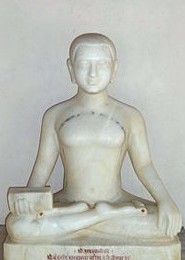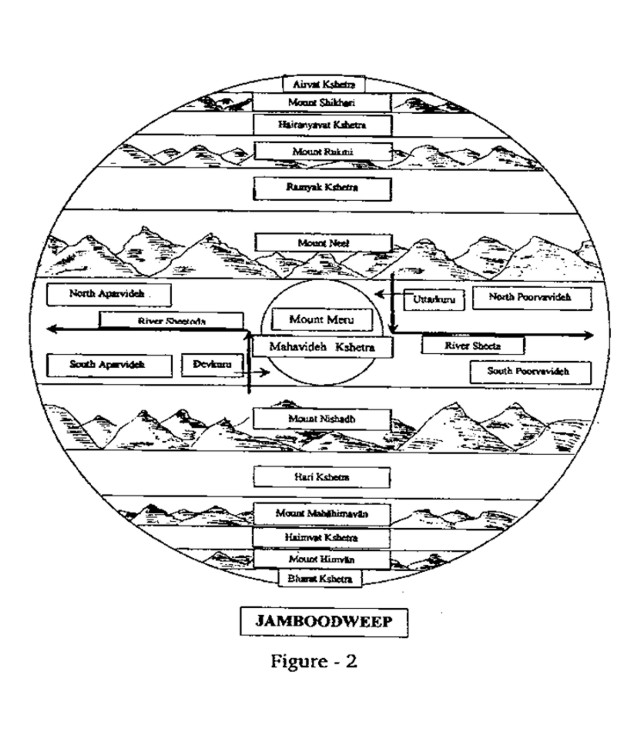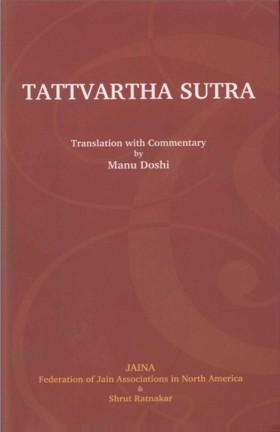03.10 Tatra Bharathaimvatharividehramyakhairan-yavatairavatvarshāh Kshetrāni
Audio: Sanskrit: तत्र भरतहैमवतहरिविदेहरम्यकहैरण्यवतैरावतवर्षा: क्षेत्राणि । 3/10
Hindi: जम्बूद्वीप में भरतवर्ष, हैमवतवर्ष, हरिवर्ष, विदेहवर्ष, रम्यकवर्ष, हैरण्यवतवर्ष और ऐरावतवर्ष नामक सात क्षेत्र हैं।
03.11 Tadvibhājinah Poorvāparāyatā Himvanmahāhim-vannishadhneelrukmishikharino Varshadharparvatah
Audio: Sanskrit: तद्विभाजिन: पूर्वापरायता हिमवन्महाहिमवन्निषधनीलरूक्मिशिखरिणोवर्षधरपर्वता: । 3/11
Hindi: उन क्षेत्रों को पृथक् करनेवाले और पूर्व-पश्चिम लम्बे हिमवान्, महाहिमवान्, निषध, नील, रुक्मी और शिखरी - ये छः वर्षधर पर्वत हैं।
03.10-11
English: Jamboodweep is divided into seven continents known as Kshetras or Varshas, each of them spanning the entire width of Jamboodweep from east to west. From south to north, those continents are known as Bharat, Haimvat, Hari, Videh, Ramyak, Hairanyavat and Airāvat (commonly known as Airvat). They are separated from one another by six mountain ranges known as Varshadhars, which also span the entire width of Jamboodweep. The range that separates Bharat and Haimvat is known as Himvān, that which separates Haimvat and Hari is known as Mahāhimvan, that which separates Hari and Videh is known as Nishadh, that which separates Videh and Ramyak is known as Neel, that which separates Ramyak and Hairanyavat is known as Rukmi and that which separates Hairanyavat and Airāvat is known as Shikhari. (See figure 2)
The directions given here are from our perspective of Airāvat in the North and Bharat in the South. According to Jain concept, however, all the continents count their directions with Meru in their North. It means that the shape of Jamboodweep is not like a flat disc. It is hyperbolic like a wide inverted bowl, slightly comparable to the upper part of the northern hemisphere and the mountain Meru lies at a place analogous to our North Pole.
The central island of Madhyalok is known as Jamboodweep. Since that covers the area where we live, its description provides the Jain concept of geography. That description does not, of course, correspond to the present knowledge of geography. Some of the details are akin to those of the Hindu concept. For instance, Hindu Purans stipulate the existence of Jamboodweep and Meru of the sizes as per Jain concept. They also make mention of Dhātakidweep, Pushkarārdha, Manasottar mountain etc. Comparison of the two concepts leads us to believe that the Jain concept could be a more systematic version of the Pauranic concept.
In the central part of Jamboodweep lies Videh or Mahāvideh Kshetra, which is divided by the mountain Meru in two equal parts called Purvavideh (eastern part) and Aparvideh (western part). Both these parts are divided into northern and southern parts by the rivers Sheetā and Sheetodā. Sheetā rises from the mountain Neel and initially flowing southward, it turns east and flows towards the eastern coast of Lavansamudra. Sheetodā rises from the mountain Nishadh and initially flowing northward it turns west and flows towards the western coast of the said sea. Mahāvideh Kshetra is thus divided into four major divisions.
Each of those four divisions is further divided into eight subdivisions known as Vijay. As such, there are 32 Vijays in that Kshetra. Of these 32 subdivisions, the mention should be made of those lying on the northern bank of Sheetā, as they are more frequently referred to in Jain literature. They are known as Kutch, Sukutch, Mahākutch, Kutchkāvati, Āvarta, Mangalāvarta, Pushkalāvarta and Pushkalāvati. Lord Simandhar, the extant Tirthankar is supposed to live in Pundarikini, which is believed to be the capital city of Pushkalāvati. In addition to those 32 Vtjays, there are two regions attached to Mahāvideh. They are known as Devkuru and Uttarkuru. Devkuru lies in the space between Meru and Nishadh, while Uttarkuru between Meru and Neel.
Jamboodweep thus consists of seven main continents, six mountain ranges, two regions of Devkuru and Uttarkuru and 56 islands lying in Lavansamudra. Bharat and Airāvat, Haimvaī and Hairanyavat, Harivarsha and Ramyagvarsha, Devkuru and Uttarkuru, Purvavideh and Aparvideh are equal and lie opposite each other.
 Acharya Umaswati
Acharya Umaswati

